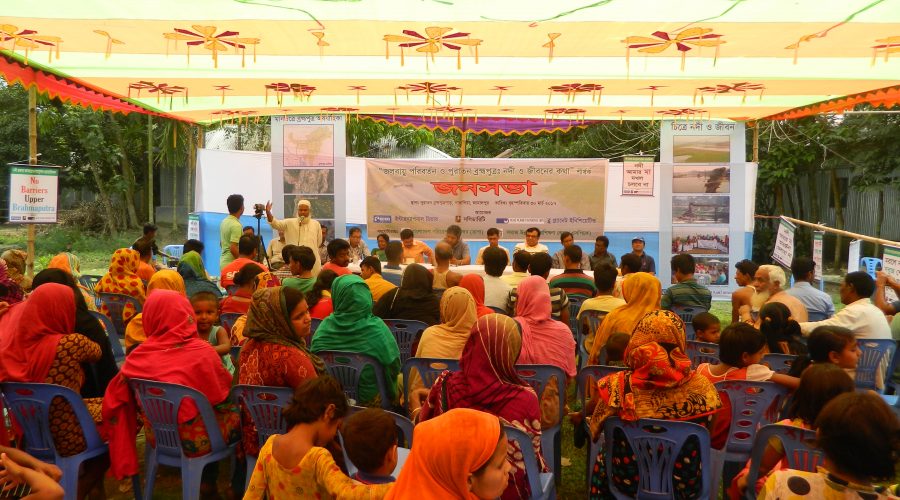Movement to Protect the Old Brahmaputra River and Its Community - WATERKEEPERS BANGLADESH
- Activities
- Movement to Protect the Old Brahmaputra River and Its Community
- August 4, 2017
- admin

Waterkeepers Bangladesh together with other regional, national and local organizations arranged a community meeting with the people of Pathaliya, located in Jamalpur district in Bangladesh. The community meeting was held to get information about the understanding of the communities living in Brahmaputra basin and people who are facing extreme climate variability in the hydrological cycle. To share the experience of the community how they are adopting the erratic weather patterns that results in high level flood, erosion and drought, Waterkeepers Bangladesh was the first that took this initiative.

The village Pathaliya situated by the bank of Brahmaputra River, formally known as Old Brahmaputra. This Old Brahmaputra once was very important for the commercial transportation. A large number of people of this community are engaged in the fishing and farming sector. The density of population is 1,100/Km2. Jamal Upazila is considered as an important market center for rice, sugarcane, jute, tobacco, and mustard produced in the region. However, Brahmaputra river is the main source of river bank erosion and floods which are the main hazard of the community. An attempt was made to get community’s perception on climate change and its impact related issues.
There is huge crisis of water for irrigation in the dry season as the water goes much below the water level. The main flow of river has changed and the canals adjacent to the main rivers have extinguished. On top of these, river erosion is a major problem that tremendously shattered the household, crops, cattle and human life. Due to the sedimentation and no flow during winter as the mouth of Old Brahmaputra in Jamalpur is almost blocked, the navigational transportation through that waterway is completely broken down that impacted the commodity price and national economy. During the meeting with the community people, they addressed the following disasters such as river erosion, flood, Kalbaishakhi, drought, river siltation, heavy rainfall, cold wave and hailstorm are tremendously hampering their livelihood in last few years. According to the community people river erosion and floods starts from the month of Ashar (June-July) and continues up to the month of Bhadro (August-September) usually. As a result, crops, houses, roads and trees are devoured up by the rivers. Dams, Barrages, Embankments, Sluice Gates and encroachments on the river course have tremendously destroyed the natural structure of Old Brahmapurta. On the other hand, drought is considered to be one of the most devastating disasters in the community life of Jamalpur District.

The community demanded dredging of the Old Brahmaputra River to ensure flow of water throughout the year. They also demanded removal of all sluice gates that are obstructing free flowing water to the connected canals and wetlands. Throughout the discussion meeting, mitigation measures like increasing the depth of river beds, ensuring natural flow to the river, sufficient tree plantation on both sides of rivers, disaster management training etc. were demanded by the people. People are being assured to enhance community collaboration for climate resilience in the Brahmaputra basin. Nevertheless, the community claimed that no positive mitigation measures have been taken by either the local government authority to address the threats or by the national policymakers to ensure the natural flow to the Old Brahmaputra River.


